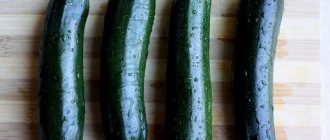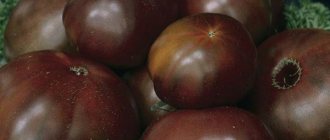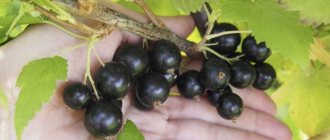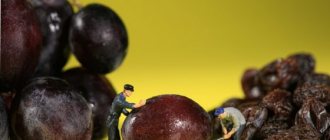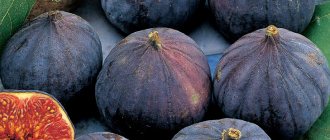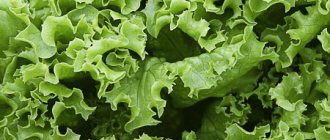Eggplant “Black Beauty”: reviews, photos, yield
Not all vegetable growers grow eggplants, considering them too capricious a vegetable crop. However, among the varieties and hybrids of these vegetable plants, thanks to the efforts of breeders, varieties have appeared that, with stable and high yields, are resistant to changes in weather conditions and resistant to many diseases that affect other vegetable crops from the nightshade family.
One of these eggplant varieties is Black Beauty, the positive qualities of which will be discussed below.
The content of the article:
1. History of creation 2. Description of the “Black Beauty” variety 3. Productivity of the variety 4. Advantages 5. Diseases and pests 6. Growing and caring for the “Black Beauty” eggplant variety 7. Reviews of the “Black Beauty” eggplant variety 8. Information from manufacturer
Reviews from gardeners
Those who have already tried to grow Black Beauty on their plot recommend this variety for cultivation.
Olga, Ulyanovsk region: “I have never tried to grow eggplants - I always thought that this crop was intended for warm climates. One day, a friend recommended the Black Beauty variety. I received a bountiful harvest of shiny, dark-colored fruit, as advertised, with great flavor.”
The Demidovs, Syzran: “My husband and I love to grow new varieties of various crops. Last season, a garden store noticed a beautiful package of seeds with a photo of unusually shaped eggplants. This was the Black Beauty, which we now constantly cultivate and recommend to others.”
Nina Vasilievna, Tambov: “The black beauty grows in my greenhouse and bears its first fruits 2 weeks earlier than in open ground. It has an excellent taste and is indispensable for homemade preparations. I recommend this variety to everyone."
Eggplant “Black Beauty”: characteristics and description of the variety
This variety belongs to the mid-early vegetable crops in terms of ripening time - in the garden beds the first fruits are harvested after 4 - 4.5 months, and in greenhouse conditions - 12-14 days earlier. Eggplant is resistant to most diseases characteristic of other varieties of this vegetable plant, and fruit ripening does not stop even with a sharp change in air temperature and in rainy weather.
The bushes of this variety are below average in size, well branched, the first buds appear on the lower shoots. The foliage is a rich green color, slightly wrinkled.
Photo of eggplant Black handsome
Ripe eggplants have the shape of an ellipse, the color of the shiny skin is dark purple. The length of the fruits grows to 14-14.5 cm, their diameter is 11.5-1.2 cm. The color of the pulp is creamy, the taste is pleasant, ripe fruits are devoid of bitterness.
The harvested crop is universal: it can be used to prepare hot dishes and snacks, canned, frozen and dried.
Description of fruits
According to photos and reviews from gardeners, the Black Beauty eggplant has beautiful, dark-gray fruits. They are oval in shape and can be of various colors: purple, white or pink. But, as a rule, Black Beauty at technical maturity acquires a dark purple color, which is why the variety was named.
Pear-shaped eggplants are quite large, growing up to 19 cm in length, with a weight reaching 900 g. The variety has dense, creamy flesh without bitterness. It is better to eat young specimens, as they have thin skin and practically no seeds.
Fruiting is amicable and lasts up to 2 months. The first eggplants begin to ripen in the lower part of the bush, and if weather conditions permit, they ripen at the top of the bush before frost.
Distinctive advantages of the Black Beauty variety among other eggplants
The main advantages of the Black Beauty eggplant variety include:
- high productivity;
- variety resistance to most diseases;
- eggplant grows well and bears fruit even in unfavorable weather conditions;
- the harvested crop tolerates transportation well even over long distances;
- fruits can be stored in the refrigerator for up to several weeks without losing their taste;
- good presentation and taste of the fruit.
- There are practically no disadvantages to the Black Beauty eggplant.
Advantages and disadvantages of the variety
A comparison of the pros and cons of this variety will help you decide on planting “Black Beauty”.
Pros:
- high and stable yield;
- excellent marketability of fruits;
- simple agricultural technology;
- high immunity and vitality;
- universal use in cooking;
- suitable for growing in any way - in open or closed ground;
- friendly ripening of fruits;
- fruits tolerate transportation well;
- During storage, eggplants retain their taste and commercial quality.
The only thing that gardeners don’t like is its low cold resistance, up to +15 °C. But thermophilicity is a quality characteristic of both the crop as a whole and most of its varieties.
Diseases and pests of eggplant
Although the Black Beauty variety of eggplant is quite resistant to most diseases, experts recommend treating the bushes of this vegetable plant against diseases for preventive purposes as follows:
- To eliminate the possibility of late blight, eggplants are sprayed with a solution of wood ash. If the disease has already manifested itself, then the aerial part is treated with any preparation containing copper;
- against tobacco mosaic, eggplants need to be sprinkled with a solution of Fitosporin or a soap solution;
- Effective against gray rot: Horus, Antrakol and other fungicidal drugs. Eggplants affected by rot are collected and burned;
- The drug Trichodermin is very effective against blackleg.
The following “harmful” bugs can attack eggplant bushes:
- aphid;
- spider mite;
- whitefly
These pests are effectively controlled by Confidor, Fitoverm and other insecticides.
Landing
Seed material is soaked in warm water (temperature 40-45 degrees). For stimulation, you can use folk remedies or ready-made solutions (Epin, Albit, Kornevin).
The seeds are sown in a peat-humus mixture, the spacing between seedlings is maintained at 3 cm, and the seeding depth is within 1.8 cm.
Boxes and cups with seedlings are kept under film until the first seedlings hatch.
The seedlings are watered with water at a temperature of 30-36 degrees. Young bushes dive when they grow 2 leaves. Fertilizers for preparing nutrient solutions for seedlings:
- Fertika Lux;
- Bud;
- Epin Extra.
Agrotechnics of cultivation
Since in most regions of Russia the summer period is short enough and often cold to have time to get a harvest from this vegetable crop, “Black Beauty” eggplants are recommended to be grown by seedlings.
Seed material should be planted for seedlings in the last ten days of February - the first ten days of March, and the seedlings should be transplanted to a permanent place in the first half of May. If there is a high probability of return spring frosts in the region, then it is better to cover the transplanted plants with film on top so that they do not freeze.
Photo of the Black Beauty variety
Sowing seeds for seedlings and further growing the Black Beauty variety does not differ from standard care for any other variety of eggplant. Seeds are sown in containers with a nutrient substrate, and before germination, the containers are covered with polyethylene to create a greenhouse effect. Usually, friendly shoots appear 10-12 days after sowing.
Further care of the “Black Beauty” seedlings comes down to regular watering, loosening the soil and applying fertilizer.
We should not forget that this plant is heat-loving, so the room needs to maintain a temperature of about 20-21 degrees Celsius and air humidity of about 65%.
Seedlings should be fed twice before transplanting to a permanent location.
Usually, a solution of ammophosphate is taken as fertilizer for the first time, and a solution of mullein or chicken droppings for the second time. HIT!
• Eggplant DIAMOND
10-12 days before transplanting into the garden, eggplant seedlings are hardened off.
To do this, containers with seedlings are placed on a balcony or loggia, first for half an hour, gradually increasing the time the plants spend in the fresh air. In the last days before transplanting, young eggplants are left outside not only during the day, but also at night. Good to know!
The best type of soil in which this variety will feel comfortable is black soil.
But even on light loamy or sandy loam soils, into which organic matter and complex mineral fertilizers are added in advance, this vegetable crop will also bear fruit well. Eggplant seedlings are transplanted into open ground at the age of 2.5 months, when at least 3-4 pairs of permanent leaves appear on it.
The distance between the bushes should be at least 0.47 m, and the width of the rows should be about 0.6 m. During the period of acclimatization of seedlings in a new place, they need to be watered a little every evening for 10-12 days. Then you can water the eggplants every other day. With a lack of moisture, eggplant bushes begin to wither, and the fruits begin to taste bitter. If there is excess water in the soil, this vegetable crop may begin to hurt.
Feeding eggplants “Black Beauty”
This vegetable plant needs to be fed several times a season:
- a couple of weeks after transplanting the seedlings to the beds;
- before flowering;
- immediately after flowering;
- a couple of times during the period of fruit ripening.
Organic matter and complex mineral fertilizers are applied separately and should be alternated. When applying liquid fertilizers under the root system, you need to ensure that splashes of the solution do not fall on the foliage.
Characteristics of the variety
To decide for yourself whether Black Beauty is suitable for growing on a personal plot or not, you need to carefully study the characteristics of the variety.
Productivity and fruiting
The variety is productive, with proper care per square meter. meter you can grow up to 10-15 kg of fruit. Accordingly, up to 3 kg of blue ones ripen on one plant.
Area of application of fruits
Eggplants have been widely used in cooking in different countries since ancient times. Since the variety has a good taste, hot and cold dishes are prepared from young fruits, and also used for preservation. Overgrown ones can be dried, frozen and used to make caviar.
Resistance to diseases and pests
The variety has average immunity to many diseases. Therefore, in order not to encounter difficulties, preventive measures are carried out.
Gardeners often use bleach to get rid of blackleg, and get rid of the Colorado potato beetle by hand picking or special preparations.
Preventive actions:
- the soil and planting material are treated with potassium permanganate;
- the lower leaves are promptly removed;
- loosening the soil after watering;
- once every 2 weeks, treating the row spacing with wood ash;
- weed removal.
Advantages and disadvantages of the variety
When choosing Black Beauty eggplant for planting, you need to read its description and know all the advantages and disadvantages.
Positive side:
- easy to grow variety;
- due to rare diseases – resilient;
- high and stable yield;
- universal for use in cooking;
- suitable for open ground and for growing under film cover;
- simultaneous ripening of fruits;
- long shelf life without changing appearance and taste.
The variety has one drawback - it is low cold resistance, up to +15 degrees.
Features of planting and care
Black Beauty is a well-known variety that is grown in open and closed ground. To get a harvest you must follow:
- rules for growing seedlings;
- planting technology;
- regular care.
Seed processing and growing seedlings
To harvest as early as possible, eggplant is grown through seedlings. To obtain healthy and strong seedlings, it is necessary to purchase seeds from trusted suppliers, the first selection with the F1 mark, since they are resistant to sudden changes in climatic conditions.
The seeds take a long time to germinate and to speed up the germination process they are soaked overnight in a growth stimulator: aloe juice, honey solution, Epin or Zircon. The seedlings do not tolerate picking well, therefore, the seeds are sown in peat or plastic cups. To prevent fungal diseases, the seed material is kept in a pink solution of potassium permanganate for 15 minutes.
From the moment of sowing until the emergence of seedlings, 10-14 days pass. Therefore, in order to plant bushes in mid-May, seeds are sown at the end of February.
Important! Seedlings are planted in open beds only after the earth has warmed to +15 degrees.
The seed is planted in nutrient soil to a depth of 2-3 cm. For rapid germination, a microgreenhouse is installed so that the temperature is 20-28 degrees. After germination, the covering material is removed and the air temperature is lowered to +18 degrees. This temperature regime is maintained for about a week. After which the temperature is raised again to +20 degrees. This procedure is necessary for better growth of the root system and to prepare the plant for planting in a permanent place.
Young seedlings need a lot of light, so artificial lighting is installed above the seedlings, at a distance of half a meter.
To get healthy bushes, careful care of the seedlings is necessary:
- irrigation with warm, settled water;
- after 15 days, the seedlings are fed with mineral fertilizers;
- To prevent fungal diseases, once a month, sprinkle the soil with ash.
Planting seedlings
After the seedlings have 5-6 leaves, usually 80-90 days after sowing, the eggplants are planted in a permanent place.
Important! If you follow all the rules of planting and care, the first fruits will appear after 30 days.
The bushes grow well on black soil or loamy soil. If the soil is clayey, add ash and sand when digging. The best predecessors are: onions, melons or legumes. The soil is prepared 2 weeks before planting seedlings.
The plant is planted in rows, the distance between seedlings is half a meter, between rows - 90 cm. Fertilizers, wood ash and ground crackers are added to a hole 25 cm deep. The plant is placed in the prepared hole and carefully sprinkled with earth.
Plant care
To get a rich harvest, you must follow simple rules:
- When the first flowers appear, the plant is watered with a growth stimulant, since flowers draw a lot of energy, and fertilizing will speed up the appearance of fruits.
- When the bush reaches 40 cm, the top is pinched and no more than 10 fruits are left on the bush.
- Loosening the soil after each watering.
- Fertilizing is applied 4 times: a month after planting seedlings (complex fertilizers), during budding (potassium fertilizing), during fruit formation (nitrogen-phosphorus fertilizing), 2 weeks before harvest (phosphate-potassium fertilizing);
- Morning or evening watering with warm, settled water. Since cold water leads to fungal diseases, and open sun leads to foliage burns.
Recommendations for growing:
- Every year the plant is planted in different areas.
- Before planting, the soil is spilled with boiling water to destroy the parasite larvae and disinfect the soil.
- To increase germination, seeds are treated with a growth stimulant.
- To ensure that seedlings appear quickly, a microgreenhouse is installed.
- When seedlings appear, carefully control the temperature and humidity conditions.
- If the seeds are sown in a box, the seedlings are picked at the 2-3 leaf stage.
- To reduce moisture evaporation and the appearance of weeds, the soil is mulched.
- Timely harvesting of fruits will allow you to get more harvest, since we spend a lot of effort on each fruit and plant.
Eggplant “Black Beauty” reviews from those who planted the variety
Below are some of the reviews from those gardeners who have already grown Black Beauty eggplant in their gardens:
Ekaterina, 39 years old, Chelyabinsk:
I recently started growing eggplants in my greenhouse – just a couple of seasons ago. In the first season, I planted several different varieties of eggplants, so that I could then choose the best ones to grow in the following seasons. Of all the varieties, I liked the variety Black Beauty the most with its high yield and resistance to most diseases. I would also like to note that the bushes of this variety do not require gartering, as they do not break under the weight of ripening fruits.
Tatyana, 50 years old, Ulyanovsk:
Although our climate is not always consistently warm during the summer, I still grow eggplants in my beds and get good yields, because I have selected a suitable variety that bears fruit even in bad weather conditions - this is Black Beauty. Even in the rainy, cool season, the bushes of this variety grew actively, and the harvest was no worse than in the previous hot season. I recommend growing Black Beauty eggplant to all my friends and acquaintances who also have summer cottages.
Svetlana, 48 years old, Penza:
I have been planting Black Beauty eggplant in my garden for several seasons now and do not plan to replace it with other varieties. I am satisfied with everything about this vegetable plant: its resistance to disease, resistance to stress, and the smooth ripening of fruits.
Olga, 40 years old, Voronezh:
I first grew this eggplant in open ground beds, but then my husband installed a polycarbonate greenhouse on the plot, because in our climate it is very difficult to grow heat-loving vegetable plants in open ground. I would like to note that in greenhouse conditions, the Black Beauty variety began to bear fruit earlier, and its yield increased slightly.
Ninulia, Nizhny Novgorod region:
The black beauty is quite late-ripening, at least for our area.
Therefore, maybe he didn’t overwhelm with the harvest. A friend of mine always plants it every year, but in a greenhouse. So there she gets it, although there is not so much on the bush, but each piece is no less than half a kilo! And the total yield is greater than from a hybrid. https://www.tomat-pomidor.com/forums/topic/6160-selection-of-eggplants-for-planting-in-2017/?page=3
allexmd, Moldova, Chisinau:
A good variety, I grow this every year.
Lechka, Moscow:
I also grew this variety for the previous two years.
They bear fruit well and are not capricious. https://ogorodik66.ru/viewtopic.php?t=1503
Those vegetable growers who would like to plant new varieties of eggplant in their garden should pay attention to the Black Beauty eggplant, which ripens 4 months after transplanting the seedlings to a permanent place, gives stable yields, does not require garter and is resistant to most diseases.
Reviews about the variety
★★★★★
Victor, 47 years old, amateur gardener, Tula region. Black Beauty seeds germinate well, so I grow seedlings myself.
I sow in February and plant in the ground at the end of May. The fruits are very large and tasty, but if harvesting is late, they become bitter. ★★★★★
Dmitry, 67 years old, pensioner, Barabinsk. The variety is very tasty, the flesh is tender.
The fruits are suitable for all kinds of preparations. This year I collected 2 kg from a bush. Each eggplant weighs 200-300 g . Hide
Add your review
“Black Beauty” can produce a good harvest only under favorable growing conditions and with proper care. The reward for the work done will be high yields of excellent-tasting eggplants.
0
0
Copy link
Eggplant Black Beauty: description and characteristics from the manufacturer
Mid-season (110-145 days from germination to fruiting) variety. The plant is semi-spreading, 0.6-0.7 m high. Recommended for film shelters and greenhouses. Sowing of seedlings is carried out at the end of February. Picking in the cotyledon phase. Planting seedlings - end of May. Shaping: removing all side shoots and leaves up to the first fork. By the end of July, 5-6 of the largest ovaries are left on the plant, other flowers and ovaries are removed.
In the southern regions it is grown in open ground by direct sowing in March-April. The fruits are pear-shaped, 18-20 cm long, brown-violet in color, with a glossy surface, weighing 112-200 g. The pulp is yellowish-white, without bitterness, with excellent taste. Planting pattern 40x60 cm. Productivity of one plant is 3.0-6.5 kg/m2.
Manufacturer: Gavrish, Search, Russian Vegetable Garden, Successful Seeds and others.
Transplantation and subsequent care
The readiness of eggplant seedlings for transplanting can be easily determined by their appearance: the stem has reached a height of 20 cm, and it has 5-6 well-developed leaves. It is impossible to overexpose seedlings - if they are not planted in the ground in time, then there simply will not be enough space for the development of the root system. The photo shows eggplant seedlings that have reached transplanting maturity.
Prepared seedlings are planted at a distance of 40-50 cm from each other. The first fertilizing with mineral or organic fertilizers is carried out on the 10th day. Black beauty, like other eggplant varieties, does not tolerate drought. Excess moisture can also harm young plants. Therefore, watering should be frequent and moderate.
Treating eggplants with biological stimulants will help achieve a good harvest. During the entire growing season, this is done only three times. The first is soaking the seeds in a solution before sowing, then during the flowering period and with the appearance of the first ovaries.
Over the entire period of growth, the Black Beauty bush, if not looked after, can grow up to 1.5 m. Formation of the bush is a mandatory procedure when growing this variety. All leaves and shoots that are below the first fork are removed. The top of the main trunk is carefully pinched as soon as it reaches a height of 30-35 cm. The smallest buds and ovaries should also be removed - for good fruiting, no more than 10 of them are enough for one bush.
Growing Tips
- It is not advisable to plant eggplants next to tomatoes.
- Plant Black Beauty in the ground when warm weather sets in, when the air temperature does not drop below 15 degrees and night frosts do not “threaten” (late May or early June for the middle zone).
- Change the location of planting eggplants annually.
- Before planting seedlings, it is necessary to disinfect the bed, for example, pour boiling water over it in order to destroy bacteria that cause plant diseases.
A hole is made for each seedling; the distance between them should be at least half a meter.
Eggplants get sick when transplanted, so it is better not to disturb them for 2-3 days (do not loosen or water them) until they take root in the new place.
Planting and care
The “Black Beauty” variety is zoned into two regions - the North Caucasus and the Central Black Earth - and is intended for cultivation in open ground. It also grows in the Moscow region, the Central region in general and in Belarus, but when planted in open ground it does not have time to yield the entire harvest. Eggplant in these regions has to be grown in shelters - and any other plant too.
Eggplant is grown only by seedlings (details on how to properly plant eggplant as seedlings). Seedlings are planted when the threat of late frost has passed. Standard care - moderate but regular watering, fertilizing, including foliar fertilizing with solutions of microelements
It is very important not to forget about formation: the colder the climate, the fewer side shoots should be left on the plant and the fewer ovaries on each side. When grown in open ground in the conditions of the Middle Zone, leave 2 or 3 side shoots with 7 or 8 fruits, and pinch out the rest as soon as possible. If you are late in removing excess side shoots and flowers appear on them, cut the shoot after the two leaves that follow the flower
Diseases and pests
Eggplant is affected by all diseases typical of Solanaceae: late blight, verticillium, septoria, stolbur, etc.
- the list is large. Read more about disease protection in the relevant articles. Of the pests, the Colorado potato beetle is the most dangerous. In addition, aphids and spider mites are dangerous. Beetles in small areas can be controlled mechanically, but aphids and spider mites require insecticide treatments.
Officially, the yield of the “Black Beauty” eggplant is about 3.4 kg/m2, that is, at the “Almaz” level. However, summer residents say something completely different.
Growing and caring for the variety: advice from summer residents
Black beauty can be planted with seeds, but they will sprout normally only in the southern regions. In all other cases, good and early yields can only be achieved with seedlings. The growing season of the variety is very long. If you want to get a vegetable harvest by the end of summer, you should start seedlings in February. At this stage, the eggplant is capricious.
Eggplant bushes
To ensure good seedlings, follow this sequence:
Choose the right seeds. The F1 mark on the packaging means the first stage of selection and the crop’s resistance to temperature changes. Take the land that is disinfected and fertile. Treat the seeds with a growth stimulant. Provide the planted seeds with about 12 hours of daylight. You will probably have to arrange additional lighting, since there is still little sun in February. At 4-5 weeks from the time of emergence, dive the seedlings
This is important for the development of the root system.
Caring for sprouts is as follows: loosening the soil, fertilizing, spraying with water. Transplant them into seedlings soil after 80 days after germination. The seedlings should have 6-8 full leaves. If everything was done correctly, then in the open ground (or under a film) the eggplants will quickly grow in 1-1.5 months. will bear fruit. The variety bears fruit for about 2 months.
Attention! Be sure to pick ripe fruits. If they hang on the branches for a long time, they will weaken the productivity of the plant. Summer residents do not recommend growing eggplants in place of potatoes, sweet peppers, tomatoes and the eggplants themselves.
Good predecessors are carrots, cucumbers, legumes, cabbage, onions and melons. Caring for the crop in the garden is standard: hilling, loosening, moderate watering, fertilizing with potassium-phosphorus and nitrogen preparations. The variety is resistant to many eggplant diseases, but not all. For example, beware of blackleg, late blight, gray mold, as well as pests - the Colorado potato beetle, slugs and spider mites. Farmers claim that Black Beauty has a long shelf life once harvested, but its small size makes it not the best product for commercial purposes.
Summer residents do not recommend growing eggplants in place of potatoes, sweet peppers, tomatoes and the eggplants themselves. Good predecessors are carrots, cucumbers, legumes, cabbage, onions and melons. Caring for the crop in the garden is standard: hilling, loosening, moderate watering, fertilizing with potassium-phosphorus and nitrogen preparations. The variety is resistant to many eggplant diseases, but not all. For example, beware of blackleg, late blight, gray mold, as well as pests - the Colorado potato beetle, slugs and spider mites. Farmers claim that Black Beauty has a long shelf life once harvested, but its small size makes it not the best product for commercial purposes.
Caring for eggplants in open ground
Temperature conditions, watering and fertilizing are especially important for eggplants. Only by providing the crop with favorable growing conditions can one count on a good harvest.
Time frame for transplantation to a permanent place
“Black Beauty” seedlings are planted in the ground 2 weeks later than in the greenhouse. Typically, seedlings are transplanted at the end of May or at the beginning of June, depending on weather conditions.
The guideline for planting eggplant seedlings is the air temperature; it should be stably fixed at +15...+18 °C.
Transplanting seedlings into open ground
It is recommended to plant eggplant seedlings in the evening if the weather is sunny, or in the morning if it is cloudy.
Transplant rules:
- A few days before planting, watering is stopped.
- 1-2 hours before transplanting, water the seedlings generously to make it easier to remove the soil ball.
- Take the plant out of the container very carefully, pinching the stem of the seedling between the middle and index fingers. With the second hand they turn the container over and pull it towards themselves.
Transfer order:
- Prepare the holes for planting. Depth – 25 cm. Distance between rows – 60-70 cm. Distance between neighboring plants – 30-50 cm.
- Remove the seedling from the pot and, holding the lump of soil, quickly move it into the prepared hole. If the seedlings are grown in peat pots, there is no need to remove the seedlings - place them in the hole along with the pot.
- Compact the soil around the stem of the seedling moderately so as not to erode the soil, but do not compact it too much.
- Water the planted seedlings with warm, settled water, spending 1.5-2 liters per plant.
- Sprinkle the plantings with mulch - humus, peat or straw. You can also use non-woven material. Spread it out and secure it before planting, and then make holes in the right places.
Watering and fertilizing
The eggplant variety “Black Beauty” needs regular watering and fertilizing
Their importance especially increases during the period of fruit formation
Watering rules:
- The bushes are watered for the first time 3-4 days after planting;
- watering frequency – once a week, taking into account the weather and amount of precipitation;
- irrigation rate – 30 liters per 1 sq. m;
- water – warm and settled;
- during the period of fruit filling and in hot weather, the frequency of watering is increased;
- Plants are watered only at the roots; the sprinkling method is contraindicated.
After watering, the soil is loosened and weeded. Mulching helps prevent the appearance of weeds. Mulch also prevents the evaporation of moisture from the soil, which reduces the frequency of watering.
To get a high yield, “Black Beauty” is fed with complex fertilizers. When introducing them, the growing season is taken into account. So, at first the plant needs nitrogen, and when the fruits begin to set and ripen, it needs potassium and phosphorus.
Rules for applying fertilizing:
- Eggplants are fed every 10-14 days, but not less than 3-4 times per season;
- the crop should not be overfed with organic matter, since plants, having received a lot of nitrogen, can actively increase green mass to the detriment of yield;
- At the beginning of the growing season, the plant needs nitrogen, and when the fruits begin to set and ripen, potassium and phosphorus.
An example of feeding eggplants:
- After transplantation, nitroammophoska is added to a permanent place (40 g per 10 liters of water). The solution rate per bush is 0.5 l.
- During flowering, complex fertilizer is applied and the bushes are sprayed with a solution of boric acid - 2 g per 10 liters of water.
- During the formation of the ovaries, a solution of mullein (1:10) is added. The feeding rate is 0.5 liters of mullein per bush.
- Next, complex fertilizers are applied as needed.
Bush formation
The purpose of formation is to limit the growth of the main stem. No more than a dozen fruit ovaries are left on one bush to obtain large fruits. Regularly pick off yellowed leaves and spoiled fruits, if any.
Treatment against diseases and pests
The variety is resistant to diseases, but requires prevention.
Recommended processing:
- against late blight – with a solution of wood ash;
- soap solution and Fitosporin help with tobacco mosaic;
- for gray rot, use “Horus” or “Anthracnol”;
- Trichodermin prevents blackleg.
The most dangerous pests:
- mole cricket - they scare it away with garlic and set traps;
- slugs - mustard and pepper are scattered against them;
- Colorado potato beetle - pollinate bushes with ash.
Harvesting
Eggplants are harvested at the stage of technical ripeness - 30-40 days after flowering. Eggplants ripen gradually and are harvested selectively. The fruits should become dark and their flesh should be firm.
The fruits are not stored for a long time; they lose their taste and freshness after 2-4 weeks. They are stored in a cellar or refrigerator.
The gardener will tell you about his experience in growing Black Beauty eggplant in the following video:
Growing and care
The main rule is to follow the regime of fertilizing and watering. Fertilizers are applied by root method. To do this, use carbamide, urea, nitrophoska before flowering. For irrigation, prepare mullein (diluted 1 to 12) or a solution of dung (diluted 1 to 15).
With the appearance of buds, phosphorus-potassium compounds are added. When fruits are set, potassium chloride and superphosphate are required for feeding. You can use foscamide, potassium nitrate. Fertilizing with yeast (15-20 g per 10 l) increases productivity.
The liquid rate per 1 m2 is from 8 to 10 liters during flowering; during the fruiting phase, the moisture requirement is 11-14 liters.
Outdoor care
In the first days after transplantation, the seedlings cannot be fed or watered; they must first take root. In the future, the “Black Prince” will need standard care - watering, fertilizing, loosening and other measures.
Watering and fertilizing
“Black Prince” is highly sensitive to watering, so you should be very careful about it.
Irrigation principles:
- Use only heated water. It is poured into large containers - for example, into an old bathtub or barrel, where it is heated by the sun.
- The best way to water is in a hole made around the perimeter of the plant.
- It is better to water eggplants in the evenings, when the heat subsides.
- The approximate watering rate is 1 liter of water per bush. Frequency – once every 3-4 days.
Features of feeding eggplants:
- Fertilizers are applied 3-4 times during the growing season.
- The first time fertilizing is applied 3 weeks after planting. 1 liter of humus or mullein solution is poured under each bush. This or that organic fertilizer is diluted in a bucket of water - 2 and 1 kg, respectively.
- Two weeks later, a second fertilizing is applied - a superphosphate solution. 20 mg of fertilizer is dissolved in 10 liters of water. Watering rate is 1 liter per bush.
- At the stage of fruit formation, organic matter is added again, as during the first feeding.
- After two weeks, water the plantings with a solution of fresh mullein diluted with water 1:10.
Soil care
Loosening and weeding when growing eggplants are mandatory activities.
Soil care rules:
- The soil is loosened after each moistening - watering or rain - to prevent the formation of a surface crust.
- In parallel with loosening, weeding is carried out.
- After loosening the soil, mulch with mown grass or sawdust.
Diseases and pests
The variety has good immunity. “Black Prince” practically does not suffer from late blight, phytoplasmosis and tobacco mosaic.
Diseases and pests:
- Blackleg. To prevent this dangerous disease, it is necessary to properly water and loosen the plantings. Over-watering should not be allowed.
- Gray rot. Crop rotation, soil disinfection, and removal of plant debris can help prevent disease. They are treated by spraying the bushes with Fitosporin or Trichodermin.
- Colorado beetle. This is the main enemy of eggplants. Its larvae are capable of destroying all plants in a matter of days. Ways to fight:
- manual collection - daily or even more often;
- dusting bushes with sifted ash - 10 kg are spent per 1 hectare;
- spraying with “Fitoverm” (per 1 liter of water – 1 ml) or “Akarin” (per 1 liter of water – 2 ml);
- Aphid. This insect sucks juices from plants, reducing productivity and even leading to death. You can fight aphids in different ways:
- mechanical destruction - insects are washed off with warm water;
- sprayed with a soap-ash solution, garlic, onion or tobacco decoction;
- treated with Fitoverm, Aktara, Iskra, etc.
From the history of the creation of the variety
Black beauty is a relatively young variety. In its description in various sources, there are inaccuracies in the characteristics of the properties of eggplant and the history of its creation. In fact, everything is elementary.
Interesting!
In English, Black Beauty sounds like Black Beauty (black - black; beauty - beauty). This is the name of a Dutch variety of eggplant that has existed for a long time. It is this fact that has caused some confusion.
The black beauty was created by breeders of the Poisk agricultural company from the Moscow region. In addition, the vegetable was positioned for growing on small plots or farms. The variety was included in the State Register of the Russian Federation in 2006. Eggplant was recommended for cultivation in open ground. But in central Russia and the northern regions there are not enough warm days for the vegetable to ripen. Under a film cover or in a greenhouse, even in cool climates, eggplant pleases gardeners with abundant harvests.
Description of eggplant Black Beauty
Black Beauty is a mid-season variety created relatively recently. Brought out by Russian breeders at the end of the last century, and registered in the State Register only in 2006. Recommended for cultivation in the Central Black Earth Region and the North Caucasus, but is popular not only in these regions.
In greenhouse conditions, it is also grown in more temperate latitudes - in the Middle Zone, in the Middle Volga, in the Volga-Vyatka region and even in the North-West of our country. The variety is not cultivated for commercial purposes, but is grown exclusively in private farmsteads.
What does the plant look like?
The eggplant bush is semi-spreading and does not grow large:
- its height rarely reaches 70 cm;
- internodes are short. The thick and strong stem and the same shoots are able to withstand heavy large fruits;
- leaves are rich green, thorny, medium sized. The edges are carved;
- The flowers are purple, with a yellow center, and quite large.
Appearance and taste of fruits
The fruits of the variety are very remarkable in appearance:
- they grow short but wide. Weight - up to 250 g, and with quality care, larger specimens are also found. Shape: pear-shaped;
- the skin of the fruit is thin, but strong, smooth and shiny;
- the color of vegetables is dark purple, almost black;
- tender pulp of a greenish or yellowish tint, quite dense, contains a small amount of seeds;
- the taste is excellent, rich eggplant without bitterness. Young fruits can be eaten directly with the skin.
Benefits of eggplant
In the east, eggplant is considered a vegetable of longevity due to the fact that it has a beneficial effect on the heart and blood vessels, promoting their better functioning. This amazing vegetable came to us from India, where it was cultivated 1500 years ago.
Eggplant is rich:
- vitamins A, B1, B2, B5, C, PP;
- micro- and macroelements - K, Ca, F, P, Na, Mg, Cu, Ko, etc.;
- soluble sugars;
- pectin;
- fiber;
- proteins and fats;
- tannins;
- organic acids, etc.
Thanks to its rich chemical composition, eggplant has a positive effect on the functioning of almost all organs. If you constantly eat blue vegetables, your blood composition will improve, hemoglobin will increase in people suffering from anemia, and liver cells will be restored in people with liver diseases.
Eggplants are useful for chronic kidney diseases and intestinal dysfunction; they will lower blood sugar and cholesterol levels and cope with colds and infectious diseases. The vegetable contains a minimum of calories, so it is widely used in diet food for weight loss.
It is worth remembering that eggplant contains the poisonous alkaloid solanine, so the vegetable can only be eaten after heat treatment. For the same reason, overripe fruits should not be used.
Application
You can talk about the use of these wonderful vegetables for a very long time, since there are many culinary recipes for preparing eggplants. In short, we can only say that they are pickled, fermented, salted, fried, smoked, baked, stuffed, added to canned salads and snacks, made into caviar, frozen and even dried.
When the fruits ripen
Black Beauty is a medium-ripening variety. Its growing season from the beginning of germination is 110-115 days. The first fruits begin to ripen at the end of July. Fruiting lasts until mid-September. The harvest is removed as the vegetables ripen.
Yield indicator
This type of crop is considered almost the most productive. One plant produces about 3 kg of eggplants. From 8 to 12 kg of vegetables are harvested from one square meter, and 336 centners from one hectare.
Shelf life and transportation
The fruits of the Black Beauty are stored well in the refrigerator. If you follow all storage conditions (do not wash vegetables before putting them in the refrigerator and do not place them in plastic bags), then eggplants will be stored for about 2 weeks. Vegetables of this variety tolerate transportation well without losing their appearance or taste.
Attitude to weather conditions
This species is not highly cold-resistant. It also does not tolerate heat, drought, or sudden temperature changes. With prolonged heat or too humid and cool weather, there is a risk of flowers and ovaries falling off, and the plant itself may become sick. The variety requires watering.

